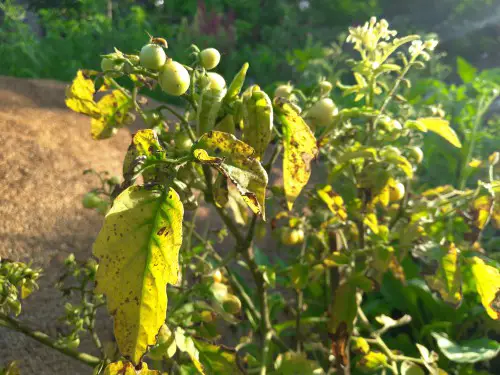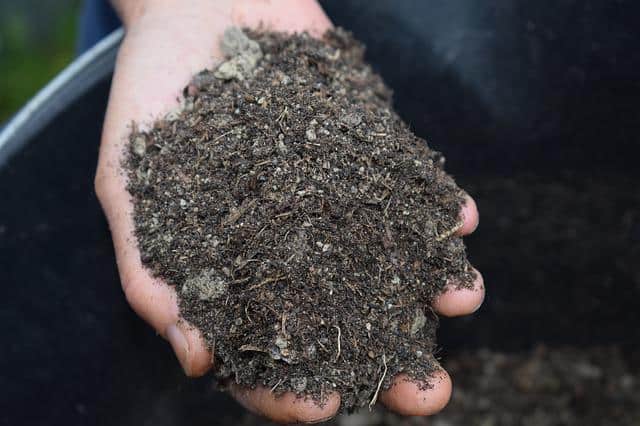Tomatoes are a popular vegetable to grow in home gardens. However, tomato plants are also susceptible to a variety of diseases that can cause damage to the leaves, stems, and fruits.
One of the most common issues that tomato growers face is the appearance of black spots on tomato plant leaves. These spots can be caused by a number of factors, including fungal infections, bacterial infections, and insect infestations.
Identifying the cause of black spots on tomato leaves is important in order to effectively treat the issue. Septoria leaf spot, early and late blight, and aphids are some of the leading causes of black spots on tomato leaves.
Fungal infections are often the culprit, and these can be treated with fungicides. It is important to check the tomato plant leaves frequently to prevent aphids and other insect infestations that can lead to black spots.
Prevention is key when it comes to black spots on tomato leaves. Proper plant care, such as watering at the base of the plant and improving air circulation, can help prevent the spread of disease.
Regularly inspecting the plant for signs of disease and promptly treating any issues can also help prevent the spread of black spots. With proper care and attention, tomato plants can thrive and produce a bountiful harvest.
Key Takeaways
- Identifying the cause of black spots on tomato leaves is crucial for effective treatment.
- Prevention is key to avoiding black spots on tomato leaves, including proper plant care and regular inspection.
- Prompt treatment of any disease issues can help prevent the spread of black spots on tomato plants.
More on this category:
- Tiny Black Spots on Succulent Leaves
- Tiny Black Spots on Fan Leaves
- Black Spots on Lemon Tree Leaves
Identifying Black Spots on Tomato Leaves

Tomato plants are a popular choice for home gardeners and commercial growers alike, but they are prone to various diseases that can affect their growth and yield. One of the most common issues is the appearance of black spots on tomato leaves.
In this section, we will discuss the symptoms of black spots and the common diseases that cause them.
Symptoms of Black Spots
Black spots on tomato leaves are easy to identify. They usually appear as dark lesions on the leaves, and in severe cases, they can spread to the stems and fruit.
The spots are usually circular or irregular in shape and can range in size from small dots to large patches. The lesions may have a yellow halo around them, and the affected leaves may turn yellow and eventually die.
Common Diseases Causing Black Spots
Several diseases can cause black spots on tomato leaves. The most common are:
- Septoria leaf spot: This fungal disease is caused by Septoria lycopersici and affects the lower leaves of the plant first. It spreads upwards, causing the leaves to turn yellow and eventually die. The spots are usually small and circular, with a dark brown center and a yellow halo.
- Early blight: This fungal disease is caused by Alternaria solani and affects the lower leaves of the plant first. It spreads upwards, causing the leaves to turn yellow and eventually die. The spots are usually irregular in shape, with a dark brown center and a yellow halo.
- Bacterial spot: This bacterial disease is caused by Xanthomonas campestris pv. vesicatoria and affects the leaves, stems, and fruit of the plant. The spots are usually circular and have a water-soaked appearance. The affected leaves may turn yellow and eventually die.
To prevent the appearance of black spots on tomato leaves, it is important to practice good plant hygiene and to monitor the plants regularly for signs of disease. This includes removing infected leaves and stems, keeping the soil moist but not waterlogged, and avoiding overhead watering.
Fungicides and bactericides can also be used to control the spread of disease, but it is important to follow the instructions carefully and to use them only as a last resort.
Tomato Plant Black Spots on Leaves – 3 Common Problems

Tomato plants are susceptible to various diseases that can cause black spots on the leaves. The black spots on tomato leaves can be caused by fungal infections, bacterial infections, and viral infections.
1. Fungal Infections
Fungal diseases are one of the leading causes of black spots on tomato leaves. The most common fungal diseases that cause black spots on tomato leaves are anthracnose, septoria leaf spot, early blight, and late blight.
These fungal infections can cause circular or irregular-shaped spots on the leaves that may have a dark brown margin and a lighter gray or tan center.
Anthracnose is caused by the Colletotrichum fungus and can cause black spots on the leaves, stem, and fruit of the tomato plant. Septoria leaf spot is caused by the Septoria lycopersici fungus and can cause small black spots on the leaves.
Early blight and late blight are caused by the Alternaria and Phytophthora fungi, respectively, and can cause black spots on the leaves, stems, and fruit of the tomato plant.
2. Bacterial Infections
Bacterial infections can also cause black spots on tomato leaves. Bacterial spot and bacterial speck are two of the most common bacterial diseases that cause black spots on tomato leaves.
Bacterial spot is caused by the Xanthomonas campestris bacteria and can cause black spots that are larger and more raised than those caused by bacterial speck. Bacterial speck is caused by the Pseudomonas syringae bacteria and can cause small black spots on the leaves.
3. Viral Infections
Viral infections can also cause black spots on tomato leaves. Tomato spotted wilt virus is a common viral disease that can cause black spots on the leaves, stems, and fruit of the tomato plant. Other viral diseases that can cause black spots on tomato leaves include tomato yellow leaf curl virus and tomato mosaic virus.
Disease Lifecycle and Spread

1. Spore Transmission
Black spots on tomato leaves are caused by various diseases that can be transmitted through spores. These spores can be carried by wind, rain, or other environmental factors.
They can also be spread by human activities such as pruning or harvesting infected plants. Once the spores land on a healthy plant, they can germinate and infect the plant.
2. Soil-Borne Diseases
Some diseases that cause black spots on tomato leaves are soil-borne. These diseases can survive in the soil for years and infect plants through their roots. They can be spread through contaminated soil, infected seeds, or plant debris left in the soil. Crop rotation and soil sterilization can help prevent the spread of soil-borne diseases.
3. Weed and Pest Transmission
Weeds and pests can also spread diseases that cause black spots on tomato leaves. Weeds can harbor disease-causing organisms and pests can carry spores or bacteria on their bodies.
Aphids and other insects can also transmit diseases from infected plants to healthy ones. Proper weed and pest management can help prevent the spread of diseases.
To prevent the spread of black spots on tomato leaves, it is important to practice good sanitation. Remove infected plant debris, rotate crops, and avoid planting tomatoes in the same spot year after year.
Copper-based fungicides and organic fungicides can also be used to control the spread of diseases. Chemical fungicides can also be effective, but should be used with caution and according to manufacturer instructions.
Prevention and Control of Black Spots
Black spots on tomato leaves are a common problem faced by many gardeners. Fortunately, there are several ways to prevent and control this issue. In this section, we will discuss cultural practices, chemical control, and biological control methods that can help keep your tomato plants healthy and free of black spots.
1. Cultural Practices

Cultural practices are some of the most effective ways to prevent black spots on tomato leaves. Here are some practices to consider:
- Crop Rotation: Rotate tomato plants with other crops to reduce the buildup of disease-causing organisms in the soil.
- Drip Irrigation: Use drip irrigation instead of overhead watering to keep the leaves dry and reduce the spread of fungal spores.
- Pruning: Prune the lower leaves of the tomato plant to increase airflow and reduce humidity around the plant.
- Staking or Trellising: Staking or trellising the tomato plant can help increase airflow and reduce the spread of fungal spores.
- Mulch: Use organic mulch to help retain soil moisture and prevent the spread of fungal spores.
- Disease-Resistant Varieties: Choose disease-resistant tomato varieties to reduce the risk of black spots on the leaves.
2. Chemical Control
Chemical control methods can also be used to prevent and control black spots on tomato leaves. Here are some chemical control methods to consider:
- Chlorothalonil: A fungicide that can be used to prevent and control fungal diseases on tomato plants.
- Sulfur: A natural fungicide that can be used to control fungal diseases on tomato plants.
- Potassium Bicarbonate: A natural fungicide that can be used to control fungal diseases on tomato plants.
3. Biological Control
Biological control methods involve using natural predators or organisms to control the spread of disease. Here are some biological control methods to consider:
- Bacillus subtilis: A natural bacteria that can be used to control fungal diseases on tomato plants.
- Compost Tea: A natural solution made from compost that can be used to control fungal diseases on tomato plants.
By implementing these prevention and control methods, home gardeners can enjoy a healthy tomato plant with delicious fruit.
Frequently Asked Questions

How do I treat black spots on my tomato plants?
The treatment for black spots on tomato plants depends on the cause of the spots. If the spots are caused by a fungal disease, the plant should be treated with a fungicide.
If the spots are caused by a bacterial disease, the plant should be treated with an antibacterial agent. It is important to identify the cause of the spots before treating the plant.
What causes black spots to appear on tomato leaves?
Black spots on tomato leaves are usually caused by fungal or bacterial diseases. The most common fungal diseases that cause black spots on tomato leaves are early blight and septoria leaf spot.
The most common bacterial disease that causes black spots on tomato leaves is bacterial spot.
What are some effective treatments for tomato leaf spot?
Effective treatments for tomato leaf spot depend on the cause of the spots. Fungal diseases can be treated with fungicides, while bacterial diseases can be treated with antibacterial agents. It is important to identify the cause of the spots before treating the plant.
Can I still eat tomatoes from plants with black spots on the leaves?
Tomatoes from plants with black spots on the leaves are safe to eat as long as the fruit is not affected by the disease. However, it is important to wash the tomatoes thoroughly before eating them.
What is the best fungicide for treating black spot on tomato plants?
The best fungicide for treating black spot on tomato plants depends on the specific fungal disease causing the spots. Copper-based fungicides are effective against many fungal diseases, while chlorothalonil-based fungicides are effective against early blight and septoria leaf spot.
Why do tomato plant leaves turn yellow with black spots?
Tomato plant leaves turn yellow with black spots when they are infected with a fungal or bacterial disease. The yellowing is caused by the plant’s response to the disease, and the black spots are a symptom of the disease.
It is important to identify the cause of the disease to effectively treat the plant.

Hey, I’m Lisa and I’ve been an avid gardener for over 30 years. I love writing, talking and living in the garden! Feel free to connect with me on my socials below


